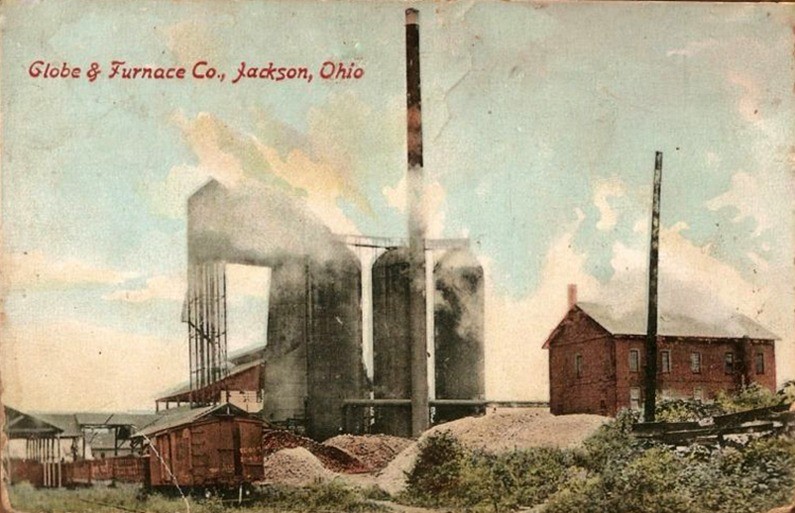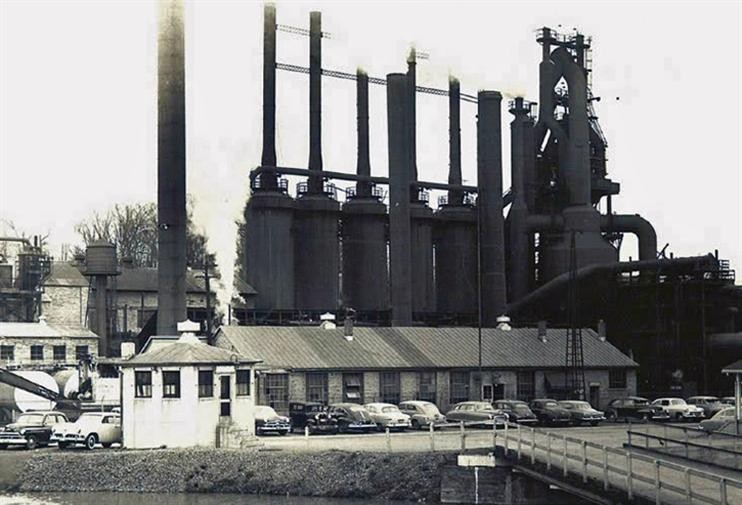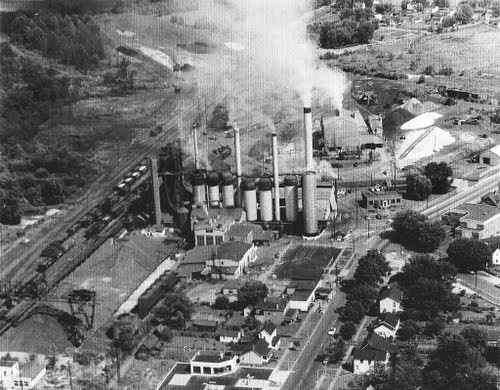Eddie Jones Park
Introduction
Text-to-speech Audio
Eddie Jones Park is one of several recreational and memorial parks in Jackson, Ohio. Despite its small size, the city of Jackson has a tradition of public works projects. Located on Harding Avenue, this park offers recreational activities along with its sister park, Eddie Jones Ball Field. The most recent addition to Eddie Jones Park is a scenic bike and walking trail that runs along Salt Lick Creek where one is likely to see deer and other wildlife that inhabit the forests that surround the city. The land was donated to the city by local philanthropist Edwin A. Jones, known locally as "Eddie."
Images

Globe Iron 1911

Globe iron 1917

Globe Iron 1950

Globe Iron on Main Street. Walgreen's is directly adjacent from the former location of Globe Iron.


Backstory and Context
Text-to-speech Audio
Eddie Jones Park and Eddie Jones Ball Field both sit on land that once belonged to the Globe Iron Company and was donated to the city by Edwin A. Jones. The Globe Iron Company was founded in 1872 by Thomas T. Jones, a Welsh immigrant and progenitor of the Jones family in Jackson, Ohio.
The Globe Iron company was a major employer for the city of Jackson and was a part of the iron and coal boom of the 19th century. In the 1930s, Globe Iron was the world's leading producer of silvery pig iron, its closest competitor was JISCO (Jackson Iron and Steel Company), a company also located in Jackson. Silvery pig iron features a high concentration of silicon and is used in special applications for which normal iron will not suffice.
Globe Furnace was built by Watts, Hoop & Company and was later purchased by Thomas T. Jones. In 1876, Globe Furnace was destroyed by a fire and Fulton Furnace was then remodeled and became the sole operating furnace of the Globe Iron Company. The Globe Iron Company initially consisted of Globe Furnace and Fulton Furnace. Globe Furnace was located on North High Street where Eddie Jones Ball Field now stands. Fulton Furnace was located on Main Street where the Jackson Square Shopping Center is presently located. Jackson Square was built in the late 1960s after Globe Iron was closed following an explosion in 1960.
Fulton Furnace continued to operate during World War I, but after the war, all the charcoal furnaces in Jackson ceased production. However, coke furnaces like Globe Iron continued to operate well into the second half of the 20th century. By the end of World War I, the iron and steel industry was in decline. The discovery that a profit could be made by producing silvery pig iron, which was initially thought of as a product of a mistake in the smelting process, saved the Globe Iron Company, and the company continued operations until 1960.
In September of 1960, an explosion at Globe Iron permanently ended production. By the 1970s, all of the furnaces in Jackson County were no longer in operation. The legacy of the city and the county as a major producer of iron is remembered and celebrated. The city's schools' sports teams are known as the Iron Men and Iron Ladies, a name first suggested by former governor James Rhodes who was born in nearby Coalton and once lived in Jackson. Every year on the first Saturday in August, the city of Jackson celebrates Pig Iron Day at Man Power Park. This park is located on Main Street within one hundred yards from the former site of Fulton Furnace.
The Globe Iron company was a major employer for the city of Jackson and was a part of the iron and coal boom of the 19th century. In the 1930s, Globe Iron was the world's leading producer of silvery pig iron, its closest competitor was JISCO (Jackson Iron and Steel Company), a company also located in Jackson. Silvery pig iron features a high concentration of silicon and is used in special applications for which normal iron will not suffice.
Globe Furnace was built by Watts, Hoop & Company and was later purchased by Thomas T. Jones. In 1876, Globe Furnace was destroyed by a fire and Fulton Furnace was then remodeled and became the sole operating furnace of the Globe Iron Company. The Globe Iron Company initially consisted of Globe Furnace and Fulton Furnace. Globe Furnace was located on North High Street where Eddie Jones Ball Field now stands. Fulton Furnace was located on Main Street where the Jackson Square Shopping Center is presently located. Jackson Square was built in the late 1960s after Globe Iron was closed following an explosion in 1960.
Fulton Furnace continued to operate during World War I, but after the war, all the charcoal furnaces in Jackson ceased production. However, coke furnaces like Globe Iron continued to operate well into the second half of the 20th century. By the end of World War I, the iron and steel industry was in decline. The discovery that a profit could be made by producing silvery pig iron, which was initially thought of as a product of a mistake in the smelting process, saved the Globe Iron Company, and the company continued operations until 1960.
In September of 1960, an explosion at Globe Iron permanently ended production. By the 1970s, all of the furnaces in Jackson County were no longer in operation. The legacy of the city and the county as a major producer of iron is remembered and celebrated. The city's schools' sports teams are known as the Iron Men and Iron Ladies, a name first suggested by former governor James Rhodes who was born in nearby Coalton and once lived in Jackson. Every year on the first Saturday in August, the city of Jackson celebrates Pig Iron Day at Man Power Park. This park is located on Main Street within one hundred yards from the former site of Fulton Furnace.
Sources
Megan Melone (Director of the Lillian E. Jones Museum). Interview about historical sites in Jackson County, February 10, 2018.permanent Collections. Jonsemuseum.com. Accessed March 29, 2018. http://www.jonesmuseum.com/permanent-collection.
Our Town: Jackson. WOUB Public Media, 2017.
Jackson Co. Ohio in the Iron Age. Jacksoninfo.net. . . http://www.jacksoninfo.net/iron-age.html.
Globe Iron and JISCO Furnace- the Furnaces of the 20th Century. . . http://www.jacksonohio.org/history.html.
